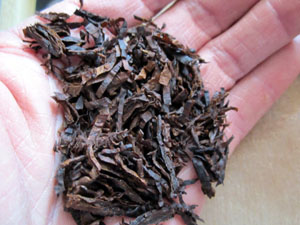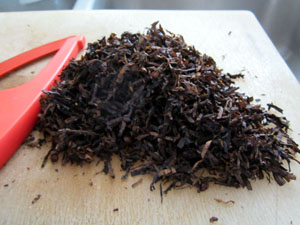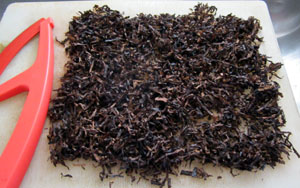Making Cavendish Cut
Cavendish Cut tobacco is basically a stacked ribbon. If a moist press cake is sliced, the shred will partially adhere, and give us that typical appearance of Cavendish Cut. Since many of the shreds are stacked and stuck together, it tends to burn more slowly. Shred width should be between 1/8" and 1/16". Start by cutting the press block into 1" wide strips. This will produce shred of 1 to 1-1/2" in length, after it is rubbed out.
The rocking action of the 6" kulu blade [Kuhn Rikon, $15] easily cuts the press cake in one pass.
Carefully rocking the kulu across the width of the cut strip quickly produces the shred. If this were a taller press cake, say 1" thick, the same pressing and slicing process makes standard "flake," but takes considerably more muscle to cut.
This can be dried as is, and later crumbled as needed into a pipe bowl for flake style.
To complete the Cavendish Cut, take a small amount of the moist flake into the palm of one hand, and gently rub it in a circular motion with the other palm. Do this just enough to loosely rub-out the flake.
It's your choice as to how much you rub-out the flake.
Once all the flake is rubbed-out to your satisfaction, spread it in a 1/2" thick layer on the cutting board to dry.
In my kitchen, at ~35% RH, the spread tobacco required more than 8 hours to dry sufficiently. Aim for low case--dry, but still flexible, then store it in a heavy Ziplock or other container.
This batch of a dozen leaves yielded a little over 2 ounces (~60g) of finished Cavendish Cut.
When you need to add moisture to the stored shred, wet a few fingers and flick a few drops into the container, then allow it to restore itself for several hours.
SUMMARY
Making Cavendish Cut Black Cavendish
- Steam some leaf until it is black.
- Press it into a cake.
- Slice the press cake.
- Rub-out the flake.
- Dry then store.
Bob


![20191215_110636[1].jpg](/data/attachments/25/25094-6be2978c19767c9b98809a290a7a60c1.jpg)











